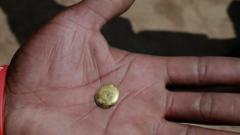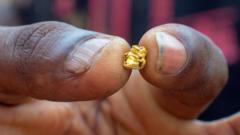As illegal mining operations burgeon in South Africa, a significant number of young boys are being trafficked, abused, and coerced into performing labor and sexual acts by organized gangs. Survivors recount chilling accounts that shed light on a darker aspect of this illicit industry, prompting urgent calls for action from authorities.
Disturbing Reality: Child Exploitation in South Africa's Illegal Mining Industry

Disturbing Reality: Child Exploitation in South Africa's Illegal Mining Industry
A recent investigation reveals the harrowing experiences of children forced into labor and sexual exploitation within the abandoned mines of South Africa.
In a shocking revelation, a new report uncovers the exploitation of children in South Africa's illegal mining sector, as detailed in an investigative piece by the BBC. These abandoned mines, once operated by large conglomerates, have become havens for criminal gangs, who are now preying on vulnerable youth in a bid to fill their ranks.
One former miner, Jonathan, recounts his six-month ordeal underground, where he observed the harrowing abuse of underage boys, some as young as 15. While many are brought in under the guise of employment opportunities, they often find themselves trapped, subjected to physical and sexual abuse by older miners. "If a boy is desperate for money," Jonathan reveals, “he will take the risk," describing the terrifying reality faced by these young boys who approach miners for protection — only to be met with exploitation.
Makhotla Sefuli, a mining researcher and activist, corroborates this disturbing trend, emphasizing that many of these children are trafficked from neighboring countries with their passports seized upon arrival. “It’s common knowledge that these young boys are being abused,” Sefuli advises, illustrating the grave conditions that parallel the illegal mining practices taking root in South Africa.
There have been multiple accounts from other former miners who witnessed similar abuses. Tshepo, another miner who chose to remain anonymous, described scenarios where older men coerced young boys into sexual acts in exchange for small sums of money or precious gold. The traumatic experiences have lasting effects, with survivors displaying altered behaviors and profound trust issues, stemming from their grim encounters.
The news of the illegal mining industry's impact gained traction following deadly police skirmishes last year, with numerous miners discovered in dire conditions beneath the earth. During recent rescue operations at the Stilfontein mine, medical tests identified 31 young victims of trafficking among the hundreds rescued. These children were often unaccompanied migrants from Mozambique who faced unimaginable trauma while trapped underground.
Gugu Xaba, CEO of Save the Children South Africa, highlighted the manipulation that occurs within the mining gangs, noting how children are treated as disposable laborers. “It’s easier to control children,” she states, stressing that these gangs exploit their lack of agency and innocence. These children not only face labor exploitation but are also targeted for sexual servitude.
Despite the rising awareness surrounding these atrocities, police and governmental responses to allegations of sexual abuse have been slow. With vast numbers of abandoned mines still accessible, the illegal mining industry is likely to continue thriving, perpetuating the cycle of exploitation and leaving countless youth at risk.
The investigation brings to light a dire need for decent protective measures for these vulnerable populations, underscoring the importance of addressing the broader implications of illegal mining and the perils it brings, especially for children caught in its crossfire.




















